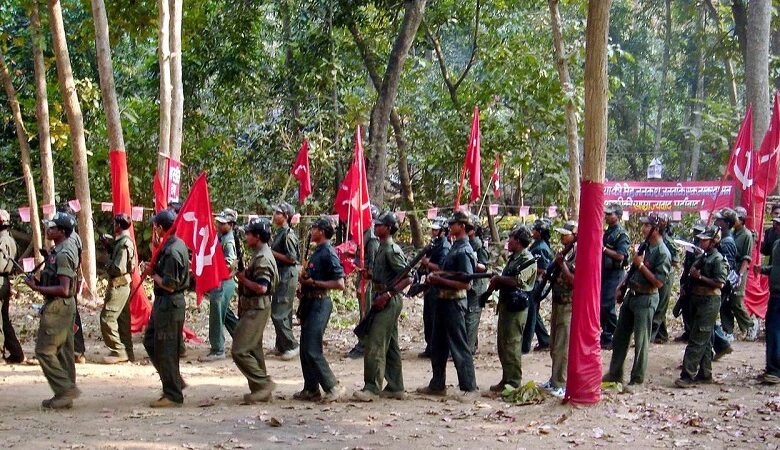An Overview of the Ongoing Naxal Insurgency in India: Efforts by Security Forces and Political Stakes

By Agnibeena Ghosh/22nd May 2024
In a series of operations in April, Indian security forces successfully neutralized at least 29 left-wing extremists, known as Naxals or Maoists, in the troubled region of Bastar in Chhattisgarh. This significant achievement highlights the ongoing efforts to combat Left-Wing Extremism (LWE) in several Indian states including Jharkhand, Odisha, Bihar, West Bengal, Andhra Pradesh, Telangana, Maharashtra, Madhya Pradesh, and Kerala, each affected to varying degrees.
The Border Security Force (BSF) and the District Reserve Guard (DRG) executed the operation based on BSF intelligence in Kanker, a sensitive area within Bastar. The engagement resulted in the deaths of 29 Maoists, with at least one BSF member sustaining injuries. The BSF’s official X (formerly Twitter) account provided updates on this operation, underscoring its importance in the broader fight against Naxalism.
Barely three weeks after the Kanker incident, another significant encounter occurred in Bijapur district, resulting in the deaths of 12 more Maoists. This clash took place early on a Friday morning, in the Gangaloor area, under the Pidiya police station’s jurisdiction, a well-known Maoist stronghold and recruitment area. This was the second major engagement in Gangaloor in recent weeks; 13 Maoists were killed there on April 2.
The Bijapur operation began around 6 a.m. at multiple locations in and around the Pidiya forest. Bijapur Superintendent of Police Jitendra Kumar Yadav confirmed they had intelligence on the presence of approximately 150 Maoists from various factions including the West Bastar division, Darbha division, People’s Liberation Guerrilla Army (PLGA) Company 2, and Gangaloor area committee, led by commanders such as Vella and secretary Dinesh Modiyam.
A joint nighttime operation was launched involving over 800 security personnel from various units including the DRG from Bijapur, Dantewada, and Sukma, Bastar Fighters, Special Task Force (STF), CoBRA, and CRPF battalions. This coordinated effort was praised by Dantewada SP Gaurav Rai for its effective inter-district collaboration.
In January 2024, Union Home Minister Amit Shah expressed optimism about eradicating Naxalism under Prime Minister Narendra Modi’s leadership, aiming for a complete resolution of the problem within three years. Speaking at the 60th Raising Day of SashastraSeema Bal (SSB) in Tezpur, Assam, Shah highlighted the central government’s commitment to this goal.
“I believe that in the next three years under Prime Minister Narendra Modi’s leadership, the country will completely get rid of the problem of Naxalism,” Shah declared. He commended the bravery of the SSB, CRPF, and BSF in combating Naxalism, noting their critical role in pushing the movement to the brink.
Shah also lauded the SSB’s efforts in fighting terrorism in Jammu and Kashmir, alongside the CRPF, BSF, Jammu and Kashmir Police, and the Indian Army. The government commemorated the SSB’s contributions by releasing a postal stamp on its 60th Raising Day.
Shah emphasized the welfare measures implemented by the Modi administration for all Central Armed Police Forces (CAPFs), including the CRPF and other border security organizations. He noted that significant steps had been taken in the past nine years to support these forces.
Reflecting on the SSB’s history, Shah remarked, “The SSB has a rich history of being immersed in the service and protection of our country. After the India-China war, SSB was established in 1963, and after Atal ji (Former Prime Minister Atal Bihari Vajpayee) implemented the policy of ‘One Border One Force,’ SSB has been dutifully protecting the India-Nepal border since 2001 and the India-Bhutan border since 2004.”
In a related development, Uttar Pradesh Chief Minister Yogi Adityanath criticized the Congress Party for allegedly enabling the spread of Naxalism and terrorism within India. Speaking in May, Adityanath accused the Congress of losing direction post-Independence and failing to combat internal security threats effectively.
“The worst impact of a directionless Congress is that many of its leaders have continuously made malicious attempts to insult India’s culture and defame Sanatana in every way. The same condition was prevalent during the UPA government when the then Union Home Minister made a malicious attempt to insult India’s Sanatana culture and defame it in front of the world in the name of saffron terrorism,” Adityanath alleged.
He praised Prime Minister Modi’s leadership for significantly reducing Naxalite violence, confining it to only a few districts in select states. Adityanath highlighted the progress made over the past decade, attributing it to the central government’s decisive actions.
Naxalism, also known as Left Wing Extremism (LWE), remains a major challenge to India’s internal security. The Maoist ideology, encapsulated in the motto “power flows from the barrel of a gun,” drives their insurgency aimed at overthrowing the state through violent means. Naxal-affected areas, known as the ‘Red Corridor,’ span from Bihar to Tamil Nadu, covering approximately 200 districts in 16 states.
The Naxal movement began with a tribal-peasant uprising against landlords in Naxalbari village, West Bengal, in 1967, led by figures like CharuMajumdar, KanuSanyal, and JangalSanthal. The militant movement quickly spread throughout West Bengal and into other states. In 2004, two major Naxal groups merged to form the CPI (Maoist) party, which became the umbrella organization for various Naxalite factions. The Naxals have also established links with external terrorist groups like the LTTE, aiding in their acquisition of weapons and technology.
As India continues its efforts to eradicate Naxalism, the security forces’ recent successes in Chhattisgarh mark significant progress. These operations not only disrupt the Maoist infrastructure but also send a strong message about the government’s resolve to ensure the country’s internal security.






